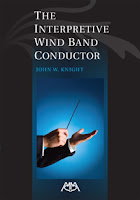It only seems appropriate that I put my own programming to the test. Of course, when examining concert presentations by contemporary concert bands or wind ensembles, a different set of criteria might be in place. (I know, it sounds as if I am adjusting the parameters so that my own work will be seen in a positive light.) Still, it is generally agreed that the modern wind band lacks the depth of the repertoire when compared to the symphony orchestra. Contributions by composers such as Mozart are limited to the wind groups of his time: usually octets presenting "popular tunes" from his operas, although Mozart is recognized for his "serious" works for this ensemble as well. These include the two serenades in E-flat (K. 375) and C-minor (K. 388) as well as the longest non-operatic work in his catalog, the "Gran Partita" (K. 361/370a). Beethoven wrote a few works for wind groups as well, but the modern conception of the wind band can be attributed to the monumental works composed during the French Revolution, culminating with a tribute to those trying times, the Symphonie Funebre et Triomphale (1840) of Hector Berlioz. Following this was the accepted golden age of the wind band, from the 1880s through the 20th century and leading to the present (more on this history in future posts).
Whereas the literature of the concert band/wind ensemble is less broad than its orchestral counterpart, it is probably as deep due to the outgrowth of activity in the educational realm and the many contemporary composers (starting particularly in the 1950s) who have deemed that the wind band is a legitimate medium for important composition. This is a worldwide phenomenon, with compositions spanning the globe. Always important for its many different schools of march compositions, serious works are constantly coming from Europe, particularly the low countries. The far east, and particularly Japan, is increasing in productivity, where composers are creating exciting and challenging works for the outstanding youth wind groups of that country. And, of course, the amount of wind music produced in the United States--in difficulty levels from very easy to vastly challenging--is definitely unsurpassed.
Thus, the wind conductor must be cognizant of his/her repertoire; there is no room for "early music specialists" or contemporary ensembles: the wind conductor has to know it all. Many in the field are constantly searching for the newest works, sort of a backlash to the "old days" in which much of the band's programming relied on transcriptions of orchestral works. It is no more viable to play only original works for band as it is to totally ignore transcriptions, marches, etc. The repertoire is both deep and eclectic, and our programming must recognize this.
 |
| Johan de Meij, b. 1953 |
- (First movement) Johan de Meij (Netherlands) "Gandalf (The Wizard)," the first movement from Symphony No. 1 The Lord of the Rings. Not to be confused with Howard Shore's film score, this work, which has become a contemporary classic, was composed from 1984-1987.
- (Second--slow--movement) Alfred Reed: Symphonic Prelude. This work, published in 1963, is based on the American folk melody, "Black is the Color of My True Love's Hair," and is in many ways reminiscent of the chorale preludes of J. S. Bach.
- (Third movement) Jean-Baptiste Arban (1825-1889): Theme and Variations from Bellini's Norma, a trumpet showpiece written in the 19th century by the leading performer/composer/pedagogue of the cornet.
- (Fourth movement) Gioachino Rossini (1792-1868): Fanfara Alla Corona d'Italia (Fanfare for the Italian Crown) actually has two separate dedications, respectively dates 1863 and 1868, the latter as a gift of thanks for Rossini's receipt of the Cavalier Great Cross of the Order of the Italian Crown. William A. Schaefer, who rediscovered the long-lost work in the archives of the British museum, states that is was written for and dedicated to Emperor Maximilian of Mexico (ruled 1864-1867) and has rescored it for contemporary concert band.
- (Fifth movement) Paul Hindemith: "March" from the Symphonic Metamorphosis on Themes from Weber's Euryanthe, transcribed with the composer's permission by Keith Wilson.
 |
| Paul Hindemith, 1895-1963 |
The second half of the program leads off with A Symphonic Movement, published in 1966 and composed by Czech emigre Vaclav Nelhybel. Hundreds of this composer's works were once mainstays of the band repertoire, but his compositions have (for reasons unknown to many) have fallen out of favor, or simply are not known to younger wind band conductors. The time is probably ripe for a renaissance of Nelhybel's music as well as that of many others of his era, for herein are the riches of the wind band tradition.
 |
| Charles Gounod, 1818-1893 |
 |
| Berlioz (1803-1869) and musicians |
One of my former teachers, when discussing what exactly makes a musical composition worthy, mentioned the all-important elements of unity and diversity: as exhibited in a classic-period rondo. I believe that this program offers the unifying elements of its "theme" as well as the diverse nature of the band repertoire. However, does this concert satisfy the criteria for the modern wind band and still serve as an informative as well as "audience friendly" concert. Of course I want to think so, as it provides works both new and old, traditional, historical and contemporary, but certainly not out of the mainstream of tonality. I am still of the school that wants to leave the audience humming a tune or two after every performance. I can only hope that this performance satisfies that goal as well.


No comments:
Post a Comment